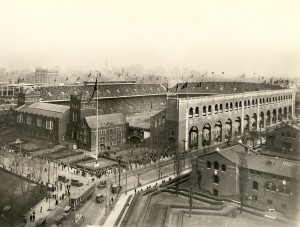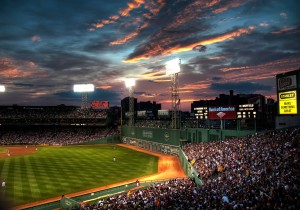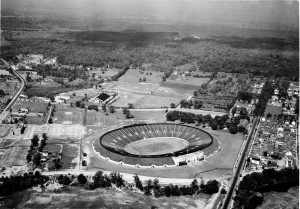Ten Oldest Stadiums in the United States
When most Americans relied on candles to see and washed clothes by hand, the first sports stadium was being laid brick by brick. Now there are more than 200 stadiums in the country, and some come with swimming pools and zip lines. Those interested in original sports stadiums should check out the 10 oldest stadiums still in use today in the United States:
1. Franklin Field
This stadium was built in 1895 for the first running of the track and field competition known as the Penn Relays. It holds the record for many firsts such as the nation’s first scoreboard, the first stadium to have an upper deck of seats and the first to broadcast a football game on the radio and on television. The National Collegiate Athletic Association recognizes Franklin Field as the oldest stadium still operating for football.
2. Harvard Stadium
This stadium was an architectural feat at the time of its construction in 1903. Led by former Civil Engineering professor Louis Johnson, the stadium’s design was the first vertical structure to use reinforced structural concrete. The material was previously only used in horizontal designs such as flooring. Many people were skeptical of the stadium’s design. It was believed that it wouldn’t hold the weight of the crowds or last through the cold New England winters. But the stadium still stands today and it was designated a National Historic Landmark in 1987.
3. Indianapolis Motor Speedway
Built in 1909, this stadium is the world’s highest-capacity sports venue at approximately 235,000 people. The original track surface was a mix of gravel, limestone and stone chips. American businessman Carl Fischer and his partners decided to pave the track with a brick surface after the mixture led to deadly accidents during races. One yard of the original brick surface is still visible at the track’s start/finish line. In 1996, NASCAR champion Dale Jarrett and his crew chief walked out to the bricks after a win and gave them a kiss. They say the kiss was inspired by a desire to honor the track’s legacy. Ever since then, winners of the Indianapolis 500 and Brickyard 500 participate in “kissing the bricks.”
Fenway is an iconic location for American baseball. The stadium is located in the Fenway neighborhood of Boston, which has a lively art scene fueled by the many students in the area. The stadium was built in 1911 under the direction of Red Sox owner John I. Taylor. He ended up throwing the first pitch at the first official game at the stadium between the Red Sox and the New York Highlanders. The Red Sox won 7-6 after 11 innings. The Highlanders changed their name in 1913 to the New York Yankees.
5. Bobby Dodd Stadium
This stadium surrounds Historic Grant Field, which is the oldest continuously used on-campus college football site outside of the northern states. The stadium was built in 1913 not by professional architects, but students at Georgia Tech. A few years after the original stadium was built, it played host to the most lopsided football games in American history. Coach John Heisman, perhaps seeking payback from their loss to Cumberland College in the previous year, led the team in a 222-0 win against the Bulldogs. To top it off, the Georgia team didn’t throw a pass in the entire game.
6. Davis Wade Stadium
Known as the second-oldest college football stadium in its division, this stadium is home for the Mississippi State Bulldogs. It was built in 1914 as New Athletic Field. A vote by the student body in 1920 resulted in the stadium changing its name to Scott Field, after Don Magruder Scott. The man was an Olympic athlete and former football star at the school. While the playing surface has kept the name, the stadium was renamed in 2001 after Floyd Davis Wade Sr. who co-founded the insurance company Aflac.
7. Wrigley Field
The home stadium for the Chicago Cubs opened in 1914 as Weeghman Park. The name came from Charles Weeghman who founded the Chicago Whales. In 1920, the stadium was renamed Cubs Park. William Wrigley Jr. of the chewing gum company took over ownership of the Cubs the following year. The stadium changed its name for the final time in 1926 to Wrigley Field. The stadium is most famous for its ivy-covered walls. According to the rules, if a ball gets stuck then the batter gets two bases. But if the ball only hits the ivy and rolls out, it is still in play.
This stadium was the largest in the world at the time of its opening in 1914. It was also the first to have a bowl shape in the country. The bowl design inspired other stadiums, such as the Michigan Stadium. Yale Bowl is often used for events other than football. Tennis matches and soccer games have taken place there, as well as the 1995 Special Olympics World Games.
9. Los Angeles Memorial Coliseum
Many give this stadium credit for bringing a wave of professional sports teams from the east coast to the west coast. Construction on the stadium began in 1921, and it officially opened in 1923 as a memorial to Los Angeles veterans of World War I. The stadium is commonly known as Olympic Stadium, with it first playing host to the games in 1932. The Olympic Torch at the stadium is still lit on significant occasions, including after the Challenger Space Shuttle disaster in 1986 and the death of Pope John Paul II.
10. Rose Bowl
This stadium sits in the sunny town of Pasadena, California. Construction completed shortly after the L.A. Memorial Coliseum in 1923. Even though this stadium is primarily used by the UCLA Bruins, it has seen several historic soccer games. Brandi Chastain had her infamous celebration at this stadium when the United States beat China in penalty kicks at the 1999 FIFA Women’s World Cup Final. The Gold Medal Olympic game between France and Brazil in 1984 attracted a record 101,799 spectators. France won the match 2-0.














